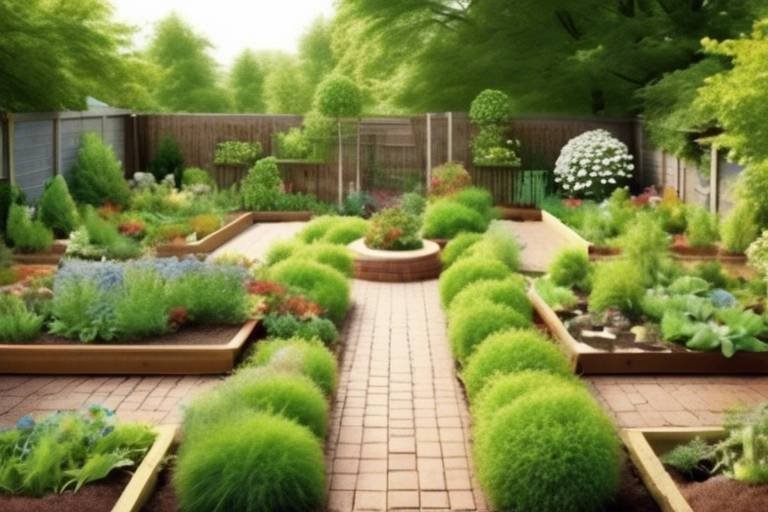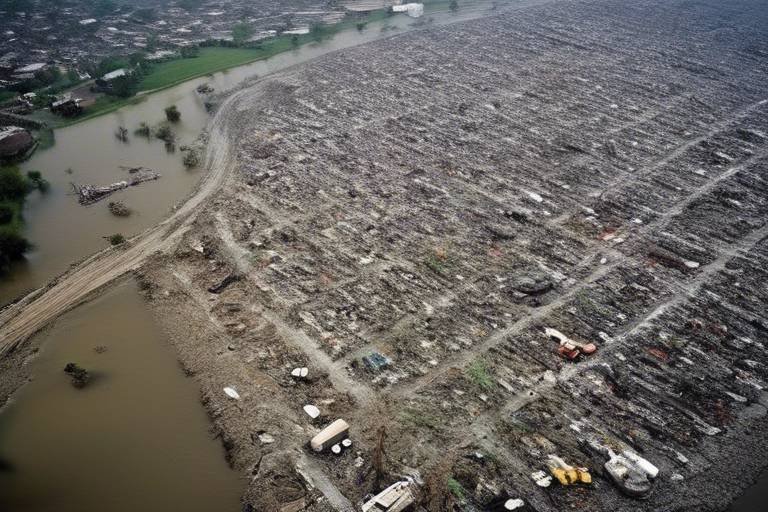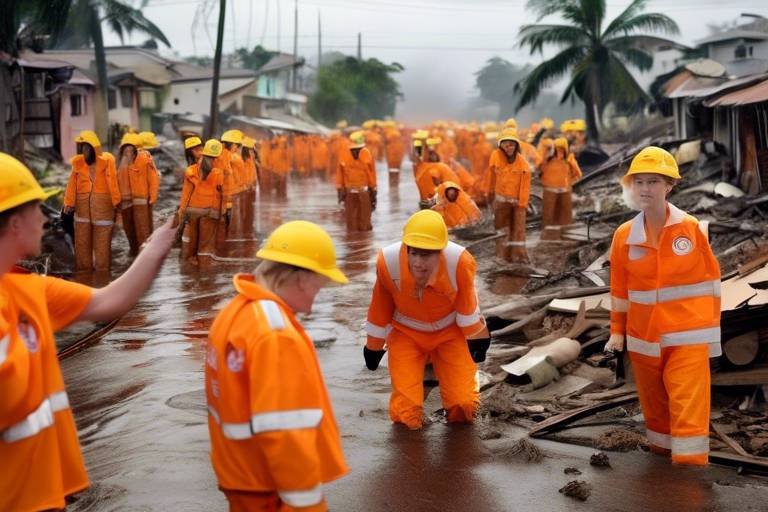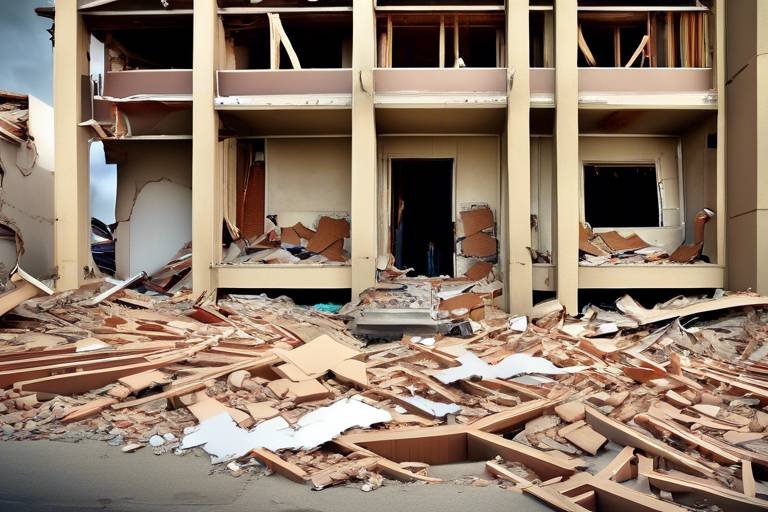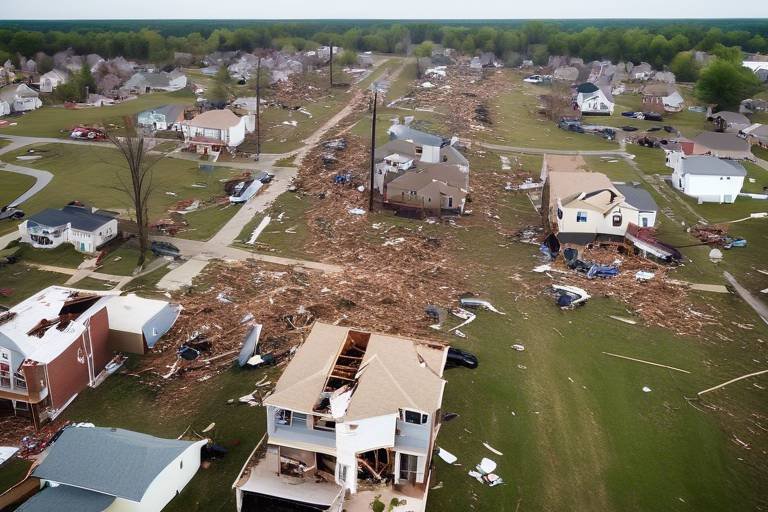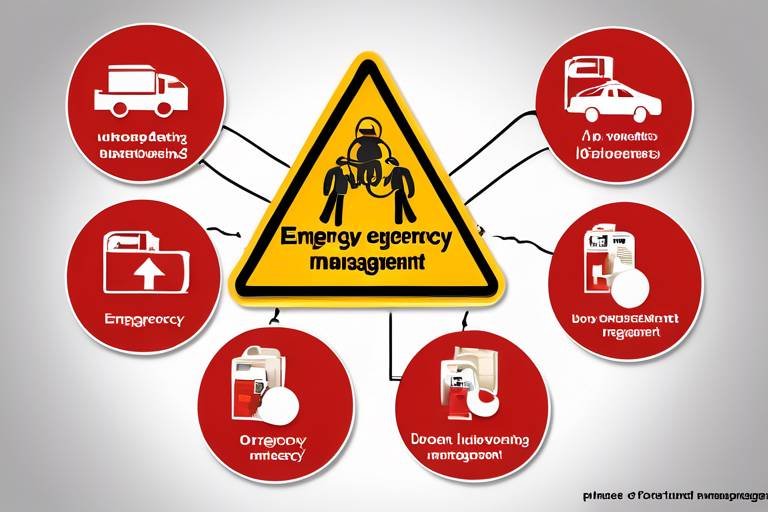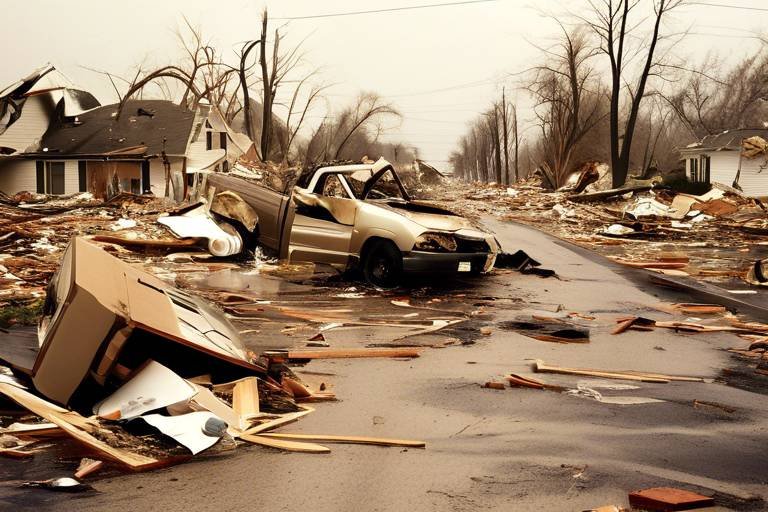How to Plan a Disaster-Proof Garden
Creating a disaster-proof garden is not just a trend; it’s a necessity in today's unpredictable climate. Imagine your garden as a fortress, designed to withstand the fiercest storms, the driest droughts, and even the most devastating wildfires. By implementing strategic planning and smart choices, you can cultivate a space that not only survives but thrives in adversity. This article will guide you through essential strategies, from selecting the right plants to designing protective structures, ensuring that your garden remains a sanctuary amidst chaos.
Before you dig into the soil, it's crucial to understand the climate you are working with. Researching local climate patterns can feel like detective work, but it’s vital for selecting plants that can endure extreme weather conditions. Consider factors such as temperature fluctuations, rainfall amounts, and seasonal changes. For example, if you live in an area prone to heavy rains, you’ll want to focus on plants that can tolerate flooding. On the other hand, if drought is a concern, opt for drought-resistant varieties. By aligning your plant choices with your local climate, you set the stage for a resilient garden.
When it comes to a disaster-proof garden, plant selection is paramount. You want to choose plants that are not only beautiful but also capable of withstanding harsh conditions. Here are some categories to consider:
- Drought-Resistant Plants: These plants thrive on minimal water and can endure dry spells. Examples include succulents, lavender, and certain grasses.
- Flood-Tolerant Plants: Look for species that can handle excess water, such as cattails and certain types of willows.
- Fire-Resistant Plants: In areas at risk of wildfires, consider plants that are less likely to ignite, like certain ground covers and native shrubs.
When planning your garden, it’s essential to weigh the benefits of native plants against non-native species. Native plants are like the locals of the plant world; they are inherently adapted to your region's climate and soil, requiring less maintenance and water. They also provide habitat and food for local wildlife, creating a thriving ecosystem. In contrast, non-native plants, while often beautiful, can bring challenges. They may struggle to adapt to local conditions, require more resources, and even become invasive, disrupting the balance of your garden.
Opting for native plants in your disaster-proof garden can yield significant advantages:
- Support for Local Wildlife: Native plants attract pollinators and other beneficial creatures, enhancing biodiversity.
- Reduced Water Usage: They are generally more drought-resistant, leading to lower water bills and less environmental impact.
- Lower Susceptibility to Pests: Native plants have evolved alongside local pests, making them less likely to suffer from infestations.
While non-native plants can add diversity and visual interest, they may pose risks in disaster scenarios. These species can be less resilient to local climate extremes, and some may even become invasive, choking out native flora and disrupting the ecosystem. It's crucial to consider the long-term impact of introducing non-native species into your garden.
Incorporating protective structures is another key strategy for enhancing the resilience of your garden. Think of these structures as shields against the elements. Windbreaks can protect your plants from harsh winds, while raised beds can improve drainage and prevent root rot during heavy rains. Consider using materials like wood, stone, or even recycled materials to create these protective features. Not only do they serve a functional purpose, but they can also add aesthetic value to your garden.
Healthy soil is the backbone of a disaster-proof garden. Without it, even the hardiest plants can struggle. Implementing best practices for soil management, such as composting, mulching, and crop rotation, can significantly enhance soil fertility and resilience. Composting, in particular, is a fantastic way to enrich your soil while reducing waste. By creating a compost system, you can improve soil structure, increase nutrient availability, and enhance water retention, all of which are crucial for a thriving garden.
Effective composting techniques can dramatically improve your garden's resilience. Start by collecting kitchen scraps, yard waste, and other organic materials. Layer them in a compost bin, ensuring a mix of greens (nitrogen-rich materials) and browns (carbon-rich materials). Regularly turning the pile helps aerate it, speeding up the decomposition process. In no time, you'll have rich compost to boost your soil health.
Implementing efficient water management strategies is essential for disaster resilience. Techniques such as rainwater harvesting and drip irrigation can optimize water use in your garden. Rain barrels can collect runoff during storms, providing a sustainable water source during dry spells. Drip irrigation systems deliver water directly to the roots, minimizing waste and ensuring your plants receive the moisture they need to thrive.
Having a solid emergency plan is critical for protecting your garden during disasters. Start by assessing potential risks in your area, such as floods, droughts, or wildfires. Create a preparedness plan that outlines evacuation measures and emergency supplies for garden care. This could include items like tarps for covering plants, extra water supplies, and tools for quick repairs. Being proactive can make all the difference when disaster strikes.
Keeping detailed records of your garden's layout, plant varieties, and care routines can aid in recovery after a disaster. Consider maintaining a garden journal or digital log that tracks your plants' growth and any changes you make. This documentation not only helps you stay organized but also provides valuable insights for future gardening endeavors.
Building a network of support within your community can enhance disaster preparedness. Connect with local gardeners, organizations, and resources for shared knowledge and assistance. You can participate in community gardening events, workshops, or online forums to exchange tips and strategies for disaster-proof gardening. Remember, a resilient garden is not just about individual effort; it’s about community collaboration.
Q: What are the best plants for a disaster-proof garden?
A: Focus on drought-resistant, flood-tolerant, and fire-resistant plants that are suited to your local climate.
Q: How can I improve my soil health?
A: Implement composting, mulching, and crop rotation practices to enhance soil fertility and resilience.
Q: What should I include in my emergency preparedness plan for my garden?
A: Consider evacuation measures, emergency supplies, and a plan for protecting your plants during disasters.

Understanding Your Climate
Assessing your local climate is crucial for selecting plants that can thrive in extreme weather conditions. Think of your garden as a canvas, and the climate as the paint that brings it to life. Without understanding the nuances of your environment, you might end up choosing plants that struggle to survive rather than flourish. So, how do you go about researching climate patterns? First, consider the temperature ranges in your area. Are winters harsh and summers sweltering? Or do you enjoy a mild climate year-round? Each of these factors plays a vital role in plant selection.
Next, examine the precipitation patterns. Is your region prone to heavy rainfall, or is drought a common concern? Understanding whether your garden will experience flooding or dry spells can help you pick the right species. For instance, if you live in a flood-prone area, you might want to focus on plants that can tolerate soggy soil, while drought-prone areas call for hardy, drought-resistant varieties.
Additionally, don’t overlook the wind patterns. Strong winds can wreak havoc on your garden, uprooting plants and damaging delicate blooms. Knowing the prevailing winds can help you design your garden layout effectively. You might consider planting windbreaks or using protective structures to shield your plants from gusty conditions.
To make your research easier, you can create a simple table to summarize the climate characteristics of your area. Here's an example:
| Climate Factor | Details |
|---|---|
| Temperature Range | Average highs and lows throughout the year |
| Precipitation | Average rainfall and dry periods |
| Wind Patterns | Common wind directions and speeds |
Finally, consider the microclimates within your garden. These are small areas that may have different conditions than the overall climate of your region. For instance, a spot near a building may receive more warmth and shelter compared to an open area. By recognizing these microclimates, you can make informed decisions about where to plant specific species for optimal growth.
In summary, understanding your climate is not just about knowing the average temperature or rainfall; it's about grasping the intricate dance between various factors that influence your garden's success. By taking the time to assess these elements, you can create a disaster-proof garden that not only survives but thrives, even in the face of nature's challenges.

Choosing Resilient Plants
When it comes to creating a disaster-proof garden, choosing the right plants is absolutely paramount. After all, you want your garden to not only survive but thrive in the face of challenges like droughts, floods, or wildfires. So, how do you go about selecting these resilient heroes of the garden? First, consider the climate conditions that are typical for your area. Are you in a region prone to long dry spells, or do you experience heavy rainfall? Understanding these factors will guide you in picking plants that are naturally equipped to handle such extremes.
One of the best strategies for plant selection is to focus on drought-resistant, flood-tolerant, and fire-resistant species. Drought-resistant plants, such as succulents and certain native grasses, store water efficiently and can survive long periods without rainfall. Flood-tolerant plants, like certain types of willows and sedges, can thrive in soggy conditions, making them ideal for areas that may experience heavy rains or flooding. On the other hand, fire-resistant plants, such as lavender and certain herbs, can help create a barrier against wildfires, protecting your garden and home.
It’s also crucial to think about the overall design of your garden. Grouping plants with similar water and sunlight needs together not only makes maintenance easier but also enhances their resilience. For instance, consider planting a mix of ground covers, shrubs, and trees that can provide shade and moisture retention for one another. This method mirrors nature’s own ecosystems, where plants support each other’s survival.
Moreover, incorporating a variety of plant species can help create a diverse ecosystem that is less susceptible to pests and diseases. When you have a range of plants, it’s less likely that a single disease will wipe out your entire garden. Think of your garden as a team; just like in a sports game, having a diverse set of players increases your chances of winning!
To make your plant selection process easier, here’s a quick overview of some resilient plants you might consider for your disaster-proof garden:
| Type of Resilience | Plant Examples |
|---|---|
| Drought-Resistant | Agave, Lavender, Sedum |
| Flood-Tolerant | Willow, Cattail, Marsh Marigold |
| Fire-Resistant | Lavender, Sage, Rosemary |
As you embark on this journey of building your disaster-proof garden, remember that the right plants can make all the difference. Not only will they beautify your space, but they will also stand strong against nature's unpredictable whims. So, roll up your sleeves, dig into the soil, and let these resilient plants work their magic!

Native vs. Non-Native Plants
When it comes to planning a disaster-proof garden, the choice between native and non-native plants can significantly impact your garden's resilience. Native plants, those that have evolved in a particular region and adapted to its unique climate and soil conditions, often prove to be the champions of survival during extreme weather events. They are like the local heroes of the plant world—familiar with the challenges their environment throws at them, from droughts to floods. On the flip side, non-native plants, while they can add diversity and aesthetic appeal, often struggle to cope with the local conditions, making them less reliable in times of crisis.
One of the key advantages of native plants is their low maintenance. Because they are naturally suited to your local climate, they require less water and fewer fertilizers compared to their non-native counterparts. This is particularly important in disaster scenarios where resources may be scarce. For instance, in the aftermath of a drought, a native plant garden will likely require less intervention and be more self-sustaining, allowing you to focus on recovery efforts without the added stress of intensive plant care.
In terms of ecological benefits, native plants play a crucial role in supporting local wildlife. They provide essential habitats and food sources for birds, insects, and other creatures, contributing to a balanced ecosystem. This biodiversity can be a significant asset during disasters, as a healthy ecosystem is more resilient and can recover more quickly from disturbances. In contrast, non-native plants may not support local wildlife as effectively, leading to a decline in local species that depend on native flora.
However, it’s essential to recognize that non-native plants can still have a place in your garden if chosen wisely. Some non-native species can be non-invasive and can complement your garden’s design without overwhelming the local ecosystem. The key is to ensure they do not disrupt the balance and that they are compatible with the local conditions. Here’s a quick comparison of the two:
| Aspect | Native Plants | Non-Native Plants |
|---|---|---|
| Adaptation | Well-adapted to local climate and soil | May struggle with local conditions |
| Maintenance | Low maintenance | Higher maintenance needs |
| Wildlife Support | Supports local wildlife | May not support local wildlife |
| Invasiveness | Generally non-invasive | Can be invasive if not managed |
In conclusion, while both native and non-native plants have their merits, opting for native species in your disaster-proof garden can lead to a more resilient and sustainable environment. They require less water, are better suited to local wildlife, and can thrive even in adverse conditions. So, as you plan your garden, consider embracing the local flora. It’s like choosing to go with a trusted friend who knows the terrain rather than a newcomer trying to find their way!
- What are the best native plants for my region? Research local extension services or native plant societies for guidance on the best native plants suited to your area.
- Can I mix native and non-native plants in my garden? Yes, but be cautious with non-native species to avoid invasiveness and ensure they complement the native plants.
- How do I know if a plant is invasive? Check local guidelines or databases that list invasive species in your area.

Benefits of Native Plants
When it comes to creating a disaster-proof garden, the choice of plants can make all the difference. One of the most significant advantages of using native plants is their exceptional ability to adapt to local conditions. These plants have evolved over time to thrive in the specific climate, soil, and ecological conditions of your area. This means they require less water, fewer fertilizers, and minimal pest control compared to non-native species. Imagine a garden that not only survives but flourishes with little intervention—this is the beauty of using native plants.
Moreover, native plants play a crucial role in supporting local wildlife. They provide food and habitat for a variety of species, including birds, butterflies, and beneficial insects. By incorporating these plants into your garden, you’re not just enhancing its aesthetic appeal; you're also creating a mini-ecosystem that promotes biodiversity. For instance, native flowering plants can attract pollinators, which are essential for the reproduction of many other plants in your garden.
Another compelling reason to opt for native plants is their low susceptibility to diseases and pests. Since these plants have co-evolved with local pests, they have developed natural defenses that make them less likely to suffer from infestations or diseases. This resilience translates into reduced reliance on chemical pesticides, promoting a healthier environment for both your garden and the surrounding ecosystem.
Let’s not forget about the environmental benefits. Native plants are typically more drought-resistant and can help improve soil health. Their deep root systems enhance soil structure and prevent erosion, which is particularly important in areas prone to heavy rainfall or flooding. This means that during a disaster, such as a storm, your garden will be better equipped to handle the stress.
In summary, the benefits of incorporating native plants into your disaster-proof garden are manifold:
- Adaptation: They are well-suited to local conditions, requiring less maintenance.
- Wildlife Support: They provide essential habitats for local fauna.
- Reduced Disease: They are naturally resistant to local pests and diseases.
- Environmental Stability: They enhance soil health and reduce erosion.
By choosing native plants, you’re not just creating a garden; you’re fostering a sustainable environment that can withstand the unpredictable forces of nature. So, why not embrace the beauty and resilience of native flora? Your garden—and the planet—will thank you!
Q: What are native plants?
A: Native plants are species that have evolved in a specific region and are adapted to the local climate, soil, and wildlife.
Q: Why should I choose native plants over non-native ones?
A: Native plants typically require less maintenance, are more resilient to local pests and diseases, and support local wildlife, making them an excellent choice for sustainable gardening.
Q: How do native plants contribute to disaster resilience?
A: They are better suited to withstand local environmental stresses, such as drought or flooding, and help maintain soil stability, reducing erosion during extreme weather events.
Q: Can I mix native and non-native plants in my garden?
A: Yes, but it's essential to ensure that non-native plants are not invasive and that they don't outcompete native species for resources.

Challenges with Non-Native Species
When it comes to creating a disaster-proof garden, the choice between native and non-native plants can be a tricky one. While non-native species often bring a splash of diversity and aesthetic appeal, they come with their own set of challenges that can undermine the resilience of your garden. One of the primary issues is their invasiveness. Many non-native plants can spread rapidly, outcompeting local flora for resources like sunlight, water, and nutrients. This can lead to a decline in biodiversity, which is crucial for a healthy ecosystem.
Moreover, non-native plants are often not adapted to the local climate and soil conditions. This lack of adaptation means they might struggle to survive during extreme weather events, such as droughts or heavy rains. For instance, a beautiful non-native flower might thrive in a nursery but fail to withstand the harsh realities of your local environment. This can lead to a garden that looks great initially but becomes a patch of dead plants when disaster strikes.
Additionally, many non-native species can be more susceptible to pests and diseases that native plants have evolved defenses against. This can result in increased pesticide use, which not only harms the environment but also poses risks to beneficial insects and soil health. In a disaster-proof garden, you want plants that require minimal intervention and can fend for themselves, and unfortunately, non-native species often require more care.
To illustrate the potential issues, consider the following table that compares native and non-native plants in terms of their adaptability, maintenance needs, and ecological impact:
| Criteria | Native Plants | Non-Native Plants |
|---|---|---|
| Adaptability | Well-adapted to local conditions | May struggle in local climates |
| Maintenance | Low maintenance | Higher maintenance required |
| Ecological Impact | Supports local wildlife | Can be invasive and disrupt local ecosystems |
In conclusion, while non-native plants might seem like an attractive option for your garden, they can introduce significant risks, particularly in disaster scenarios. By opting for native species, you not only contribute to a more resilient garden but also support the local ecosystem, making your garden a sanctuary for wildlife and a safe haven for plants during turbulent times.
- What are the best native plants for my area? Research local gardening resources or consult with a local nursery to find the best native species suited for your climate.
- How can I identify invasive non-native species? Many local extension services provide resources and guides on identifying invasive plants in your region.
- What should I do if I already have non-native plants in my garden? Consider gradually replacing them with native species and consult local experts on the best removal methods.

Creating Protective Structures
When it comes to ensuring your garden can withstand the unpredictable forces of nature, is a game changer. Think of your garden as a fortress, where each plant is a soldier ready to face the elements. By incorporating various protective elements, you can significantly enhance your garden's resilience against disasters like strong winds, heavy rains, and even wildfires. So, how do you build this fortress? Let’s dive into some effective strategies.
One of the simplest yet most effective ways to protect your garden is by installing windbreaks. These are barriers, typically made of trees or shrubs, that can shield your plants from harsh winds. Imagine standing behind a sturdy wall during a storm; that’s the kind of protection windbreaks provide. They can reduce wind speed by up to 50%, which helps prevent soil erosion and protects delicate plants from being battered. When selecting plants for your windbreak, consider native species that are already adapted to your climate. This not only enhances resilience but also supports local wildlife.
Another fantastic protective structure is the raised bed. Not only do raised beds improve drainage, but they also provide a barrier against flooding. If you live in an area prone to heavy rains, raised beds can help keep your plants’ roots dry and healthy. Plus, they make gardening easier on your back! You can build raised beds using various materials, including wood, stone, or even recycled materials. Just ensure they are deep enough to accommodate the root systems of your chosen plants.
Additionally, consider implementing canopies or shade structures. These are particularly beneficial in regions prone to extreme heat or intense sunlight. A well-placed canopy can protect your plants from sunburn and reduce water evaporation from the soil. Think of it as giving your plants a cozy umbrella on a hot summer day. You can use materials like shade cloth, which allows some sunlight in while blocking harmful rays, or even plant taller crops that can provide natural shade to smaller ones.
To further enhance the effectiveness of these structures, it’s crucial to plan their placement wisely. For example, positioning your windbreaks on the northern side of your garden can shield your plants from cold winds, while placing shade structures strategically can help maximize sunlight exposure throughout the day. Here’s a quick table to visualize the placement of these protective structures:
| Structure Type | Ideal Placement | Benefits |
|---|---|---|
| Windbreaks | Northern side | Reduces cold winds, protects from soil erosion |
| Raised Beds | Throughout the garden | Improves drainage, easier access |
| Canopies/Shade Structures | Sunny areas | Protects from extreme heat, reduces water loss |
Lastly, don’t forget about fencing! While it may not directly protect against natural disasters, a sturdy fence can keep out wildlife that might otherwise damage your plants during a storm. Think of it as the first line of defense for your garden. Whether you choose a wooden fence, a chain-link fence, or even a living fence made of thorny plants, it’s an essential addition to your disaster-proof garden.
In conclusion, creating protective structures in your garden is not just about aesthetics; it’s about survival. By incorporating windbreaks, raised beds, canopies, and fencing, you’re giving your plants the best chance to thrive, no matter what nature throws their way. So roll up your sleeves, get creative, and start building your garden fortress today!
- What are windbreaks and how do they work?
Windbreaks are barriers made from trees or shrubs that reduce wind speed, helping to protect plants from harsh weather conditions. - How high should raised beds be?
Raised beds can be anywhere from 6 to 24 inches high, depending on the plants you want to grow and your personal preferences. - Can I use non-native plants for windbreaks?
While non-native plants can be used, it’s generally better to choose native species that are adapted to local conditions for better resilience and lower maintenance. - What materials are best for building a canopy?
Shade cloth, tarps, or even natural materials like large leaves can be used to create effective canopies for protecting plants from the sun.

Soil Health and Management
When it comes to creating a disaster-proof garden, the foundation is everything, and that foundation is healthy soil. Think of your garden as a house; without a strong base, everything else can crumble. Healthy soil not only supports the plants but also helps them withstand the stresses of extreme weather. To achieve this, you need to embrace best practices in soil management that will enhance soil fertility and resilience. This includes techniques like composting, mulching, and crop rotation.
Composting is a fantastic way to enrich your soil naturally. By recycling organic waste—like vegetable scraps, grass clippings, and leaves—you create a nutrient-rich amendment that can improve soil structure and moisture retention. Imagine your garden soil as a sponge; the more nutrients you add, the more water it can hold, making your plants less susceptible to drought. To create an effective compost system, start with a mix of green materials (like fresh grass clippings) and brown materials (like dried leaves). Aim for a balanced ratio of about 2:1, and turn your pile regularly to aerate it and speed up the decomposition process.
Mulching is another key strategy for maintaining soil health. By covering the soil with organic materials like straw, wood chips, or shredded leaves, you can reduce evaporation, suppress weeds, and regulate soil temperature. This protective layer acts like a cozy blanket for your plants, keeping the soil moist during hot spells and warm during cold snaps. Plus, as the mulch breaks down, it adds even more nutrients back into the soil, creating a virtuous cycle of health and vitality.
Crop rotation is essential for maintaining soil fertility and preventing pest and disease buildup. By changing the types of plants you grow in a particular area each season, you can avoid depleting specific nutrients and reduce the risk of soil-borne diseases. For example, if you plant legumes one year, which fix nitrogen in the soil, follow them with leafy greens or root vegetables that will benefit from the enriched soil the next year. This simple practice can make a huge difference in the long-term health of your garden.
To summarize, focusing on soil health is not just a good practice; it's a necessity for anyone looking to create a resilient garden. By composting, mulching, and rotating your crops, you're setting the stage for a thriving ecosystem that can withstand the unpredictable forces of nature.
- What is the best way to start composting? Begin by collecting kitchen scraps and yard waste, then layer them in a compost bin, maintaining a balance of green and brown materials.
- How often should I mulch my garden? It's beneficial to add a new layer of mulch at least once a year, ideally in the spring, to maintain moisture and suppress weeds.
- Can I use non-organic materials for composting? It's best to stick with organic materials to avoid introducing harmful chemicals into your soil.

Composting Techniques
Composting is like giving your garden a nourishing hug! It transforms organic waste into rich, fertile soil, which is essential for a disaster-proof garden. By incorporating composting techniques, you not only reduce waste but also improve soil health, making your plants more resilient against extreme weather conditions. So, how do you get started?
First off, it's important to understand the basic components of a successful compost pile. A good mix of browns (carbon-rich materials like dried leaves, straw, and cardboard) and greens (nitrogen-rich materials such as kitchen scraps, grass clippings, and coffee grounds) is crucial. This balance is what fuels the decomposition process. Think of it as a recipe for success; too much of one ingredient can spoil the whole dish!
When setting up your compost system, consider the following techniques:
- Hot Composting: This method involves creating a pile that reaches high temperatures (between 130°F and 160°F) to speed up decomposition. To achieve this, ensure your pile is at least 3 feet wide and regularly turn it to aerate the materials. This technique can produce compost in as little as 4 to 6 weeks!
- Cold Composting: If you're looking for a more laid-back approach, cold composting is for you. Simply layer your organic materials in a bin and let nature take its course. This method takes longer, usually several months to a year, but requires less effort.
- Bokashi Composting: This unique method involves fermenting kitchen scraps using a special mix of microorganisms. It’s great for those who live in apartments or have limited outdoor space, as it can be done indoors. Once fermented, the material can be buried in the garden to enrich the soil.
Regardless of the method you choose, remember to regularly monitor your compost. It should be moist but not soggy, and you can tell it’s ready when it resembles dark, crumbly soil with an earthy smell. Not only does compost provide essential nutrients to your plants, but it also enhances soil structure, improves water retention, and encourages beneficial microorganisms.
In addition to these techniques, it's essential to consider what materials to include in your compost. While most kitchen scraps are excellent, avoid adding meat, dairy, and oily foods, as they can attract pests and create odors. Instead, focus on plant-based materials, such as:
- Fruit and vegetable scraps
- Eggshells
- Grass clippings
- Leaves
- Coffee grounds
By implementing effective composting techniques, you're not just creating a disaster-proof garden; you're also contributing to a healthier planet. So, roll up your sleeves, get your hands dirty, and watch your garden thrive!
Q: How long does it take to make compost?
A: It can take anywhere from a few weeks to several months, depending on the composting method you choose and how well you manage your pile.
Q: Can I compost meat and dairy?
A: It's best to avoid composting meat and dairy products, as they can attract pests and create odors. Stick to plant-based materials for the best results.
Q: What can I do if my compost pile smells bad?
A: A smelly compost pile usually indicates that it’s too wet or has too many greens. Try adding more browns and turning the pile to aerate it.
Q: Do I need to turn my compost pile?
A: While it's not strictly necessary, turning your compost pile helps to aerate it and speeds up the decomposition process, leading to faster results.

Water Management Strategies
Water management is a critical component of creating a disaster-proof garden. As climate change brings unpredictable weather patterns, having a solid strategy for water use can make the difference between a thriving garden and one that succumbs to drought or flooding. One effective approach is to implement rainwater harvesting. This technique involves collecting rainwater from roofs and other surfaces and directing it into storage tanks. Not only does this conserve water, but it also reduces dependency on municipal water supplies, especially during dry spells. Imagine your garden flourishing even when the skies are clear, all thanks to your rainwater collection system!
Another essential strategy is the use of drip irrigation. This method delivers water directly to the plant's roots, minimizing evaporation and runoff. With drip irrigation, you can ensure that your plants receive a consistent moisture level, which is crucial during periods of extreme heat. It’s like giving your plants a refreshing drink at just the right moment! Additionally, you can automate this system with timers to optimize water usage further and reduce labor.
Incorporating mulching into your garden can also significantly improve water retention in the soil. A layer of organic mulch, such as wood chips or straw, acts as a barrier, preventing moisture from evaporating too quickly. This not only keeps the soil cooler but also suppresses weeds that compete for water. Think of mulch as a cozy blanket for your plants, keeping them snug and hydrated!
It's also wise to monitor soil moisture levels actively. Using a simple soil moisture meter can help you determine when to water your garden effectively. Overwatering can be just as detrimental as underwatering, leading to root rot and other issues. By understanding your garden's specific needs, you can tailor your watering schedule to ensure optimal growth conditions.
Lastly, consider implementing a contour garden design. This involves shaping your garden beds to follow the natural contours of your land, which helps manage water runoff and encourages water to soak into the soil rather than wash away. By creating a landscape that works with nature, you can enhance your garden's resilience against heavy rains and flooding.
In summary, effective water management strategies are essential for a disaster-proof garden. By integrating rainwater harvesting, drip irrigation, mulching, monitoring soil moisture, and contour gardening, you can create a thriving ecosystem that withstands the challenges posed by extreme weather. Remember, a well-watered garden is not just a beautiful sight; it’s a resilient one!
- What is rainwater harvesting, and how can I start? Rainwater harvesting is the collection and storage of rainwater for future use. You can start by installing gutters and downspouts that direct rainwater into barrels or tanks.
- How often should I water my garden? The frequency of watering depends on various factors, including plant type, soil type, and weather conditions. A soil moisture meter can help you determine the best watering schedule for your garden.
- Can mulching help during drought conditions? Yes, mulching helps retain soil moisture and reduces evaporation, making it an excellent strategy during drought conditions.
- What are the benefits of drip irrigation? Drip irrigation conserves water by delivering it directly to the plant roots, reducing evaporation and runoff, and promoting healthier plant growth.

Emergency Preparedness Plans
Having a solid emergency preparedness plan is critical for protecting your garden during disasters. Think of it as your garden's safety net, ensuring that when chaos strikes, you have a roadmap to follow. Start by assessing the types of natural disasters that are most likely to affect your area—be it floods, hurricanes, wildfires, or droughts. Knowing what to expect helps you tailor your plan effectively.
One of the first steps in your plan should be to identify evacuation measures. If you live in an area prone to flooding, for instance, you might need to know which plants can be moved quickly to higher ground. Consider creating a designated space in your garden for plants that are easier to transport. This way, you can grab them quickly if you need to evacuate. Keep in mind that not all plants are created equal; some may be more resilient than others, so choose wisely!
Next, compile a list of emergency supplies that you might need to care for your garden during and after a disaster. This could include:
- Basic gardening tools (shovels, pruners, etc.)
- Watering cans and hoses
- Fertilizers and compost
- Seed packets for quick replanting
- Protective coverings (tarps, row covers)
It's also wise to have a first aid kit for both you and your plants. This kit can include items like bandages for yourself and plant treatments for any potential diseases or pests that may arise after a disaster. Remember, the aftermath of a disaster can be just as challenging as the event itself!
Documentation plays a crucial role in your emergency plan. Keep detailed records of your garden's layout, plant varieties, and care routines. This information is invaluable for recovery after a disaster. Consider creating a simple table to track your plants, their locations, and specific care instructions:
| Plant Name | Location | Care Instructions |
|---|---|---|
| Lavender | North Side | Water weekly; prune in spring |
| Tomatoes | South Side | Water daily; fertilize bi-weekly |
| Native Wildflowers | East Side | Minimal care; drought-tolerant |
Finally, don't underestimate the power of community support when it comes to disaster preparedness. Building a network of local gardeners can provide a wealth of knowledge and resources. Connect with your neighbors and local gardening clubs to share tips and strategies for disaster resilience. You might even consider organizing community workshops to educate others about emergency preparedness and the importance of a disaster-proof garden.
In conclusion, planning for emergencies is not just about protection; it's about resilience. With a well-thought-out emergency preparedness plan, you can ensure that your garden not only survives but thrives, even in the face of nature's unpredictability.
Q: What should I include in my emergency garden kit?
A: Your emergency kit should include basic gardening tools, watering supplies, fertilizers, seeds, and protective coverings. Don't forget a first aid kit for both you and your plants!
Q: How can I quickly assess the damage to my garden after a disaster?
A: Document your garden layout and plant care routines beforehand. After a disaster, refer to this documentation to quickly identify what needs immediate attention.
Q: Are there specific plants I should avoid in a disaster-proof garden?
A: Yes, avoid non-native plants that may not be well adapted to your local climate. They can be more susceptible to pests and diseases, which could jeopardize your garden's resilience.

Documenting Your Garden
When it comes to creating a disaster-proof garden, one aspect that often gets overlooked is the importance of documentation. Imagine your garden as a living, breathing entity, full of unique plants and intricate designs. Now, picture a disaster striking—whether it’s a flood, wildfire, or severe storm. Having a well-documented garden can be your lifeline in such situations, allowing you to quickly assess damage and plan for recovery.
Start by keeping a detailed record of your garden's layout. This includes the location of each plant, the types of species you have, and their specific care routines. You might think, “Isn’t that a bit excessive?” But consider this: when you have a clear map of your garden, it’s much easier to replant and restore after a disaster. A simple sketch or a digital map can save you time and frustration. Plus, documenting the growth patterns of your plants over time can provide valuable insights into their resilience.
Another crucial aspect of documentation is tracking your plant varieties. Maintain a journal or a digital spreadsheet that includes the following information:
- Plant Name: Common and scientific names
- Planting Date: When you introduced each plant to your garden
- Care Instructions: Watering, fertilization, and pruning needs
- Growth Observations: Notes on how each plant responds to weather changes
In addition to plant records, consider documenting your garden's maintenance routines. This includes when you apply fertilizers, perform pest control, or undertake seasonal pruning. Having this information at your fingertips can help you identify what works best for your plants and what may need adjustment after a disaster. You may find that certain practices make your garden more resilient over time.
Finally, don’t forget about the emotional aspect of gardening. Take photographs of your garden throughout the seasons. These snapshots not only serve as a beautiful reminder of your hard work but can also help you visualize what to restore and how to bring back the beauty after a disaster. After all, your garden is not just a collection of plants; it’s a reflection of your passion and dedication.
In summary, documenting your garden is not just a task but a vital strategy for disaster preparedness. By keeping track of your plants, their care, and your garden's layout, you equip yourself with the knowledge needed to bounce back stronger than ever after any calamity. So grab that notebook or open your favorite gardening app, and start documenting today!
Q1: Why is documenting my garden important?
A: Documentation helps you keep track of plant varieties, care routines, and layout, making recovery easier after a disaster.
Q2: What should I include in my garden documentation?
A: Include plant names, planting dates, care instructions, and growth observations to create a comprehensive record.
Q3: Can I use digital tools for documentation?
A: Absolutely! Digital spreadsheets, apps, and even garden design software can help you keep organized records of your garden.
Q4: How often should I update my garden records?
A: Regular updates are recommended, especially after significant changes such as planting new species or after seasonal maintenance.

Community Support and Resources
Building a strong network of community support is like creating a safety net for your garden during times of disaster. When the winds howl and the rains pour, having a group of like-minded gardeners can make all the difference. But how do you go about establishing these connections? First, consider reaching out to local gardening clubs or community gardens. These organizations often host workshops, events, and meetings where you can meet fellow gardeners and exchange valuable tips and resources. Imagine sharing your experiences over a cup of coffee while discussing the best drought-resistant plants or the most effective composting techniques!
Additionally, local agricultural extension services can be a treasure trove of information. They provide resources on plant selection, pest management, and sustainable practices tailored to your specific area. Engaging with these services not only enhances your garden's resilience but also fosters a sense of community as you learn and grow together.
Don't underestimate the power of social media and online forums! Platforms like Facebook, Reddit, or even Instagram can connect you with local gardening groups. You can share your challenges, successes, and even seek advice on how to handle specific disaster scenarios. Imagine posting a question about flood management techniques and receiving a flood of (no pun intended!) responses from experienced gardeners who have navigated similar situations.
Finally, consider organizing or participating in community events focused on disaster preparedness. Workshops on creating disaster-proof gardens, seed swaps, or even clean-up days after a storm can not only bolster your garden's resilience but also strengthen community ties. Remember, in gardening as in life, we are often stronger together!
- What are some local resources for disaster-proof gardening? Many communities have agricultural extension offices that provide advice on local plants and gardening practices. Additionally, local gardening clubs and online forums can be invaluable.
- How can I connect with other gardeners in my area? Consider joining local gardening clubs, participating in community gardens, or utilizing social media platforms to find and connect with fellow gardening enthusiasts.
- What should I include in my emergency preparedness plan for my garden? Your plan should include evacuation measures, emergency supplies for plant care, and documentation of your garden layout and plant varieties.
Frequently Asked Questions
- What are the best plants for a disaster-proof garden?
When planning a disaster-proof garden, it's essential to choose plants that are resilient to extreme weather conditions. Look for drought-resistant, flood-tolerant, and fire-resistant species. Native plants are often the best choice because they are adapted to local climates and require less maintenance.
- How can I assess my local climate for gardening?
Understanding your local climate is crucial for selecting the right plants. You can research climate patterns through local agricultural extensions, weather websites, or gardening books. Pay attention to factors like temperature extremes, rainfall patterns, and seasonal changes to make informed decisions.
- What are the benefits of using native plants in my garden?
Native plants offer numerous advantages, such as supporting local wildlife, requiring less water, and being more resistant to pests and diseases. They are well-adapted to the local environment, making them a smart choice for resilience in disaster scenarios.
- How can I improve soil health for my garden?
Improving soil health is foundational for a disaster-proof garden. Consider practices like composting, mulching, and crop rotation. These methods enhance soil fertility, improve water retention, and promote a thriving ecosystem in your garden.
- What water management strategies should I implement?
Efficient water management is vital for garden resilience. You can implement strategies such as rainwater harvesting and drip irrigation to optimize water use. These methods not only conserve water but also ensure that your plants receive adequate hydration during dry spells.
- How can I create an emergency preparedness plan for my garden?
To protect your garden during disasters, it's essential to have an emergency preparedness plan. Outline steps for evacuation, gather emergency supplies for garden care, and keep a record of your garden's layout and plant varieties. This documentation can aid in recovery after a disaster.
- Why is it important to document my garden?
Documenting your garden helps you keep track of plant varieties, layouts, and care routines. This information is invaluable for recovery after a disaster, allowing you to quickly reestablish your garden and ensure its continued resilience.
- How can I find community support for disaster preparedness?
Building a network within your community can greatly enhance your disaster preparedness. Connect with local gardeners, organizations, and gardening clubs to share knowledge and resources. Community support can provide you with valuable insights and assistance during challenging times.

